Defined Paraventricular Hypothalamic Populations Exhibit Differential Responses to Food Contingent on Caloric State
- PMID: 30472090
- PMCID: PMC6402975
- DOI: 10.1016/j.cmet.2018.10.016
Defined Paraventricular Hypothalamic Populations Exhibit Differential Responses to Food Contingent on Caloric State
Abstract
Understanding the neural framework behind appetite control is fundamental to developing effective therapies to combat the obesity epidemic. The paraventricular hypothalamus (PVH) is critical for appetite regulation, yet, the real-time, physiological response properties of PVH neurons to nutrients are unknown. Using a combination of fiber photometry, electrophysiology, immunohistochemistry, and neural manipulation strategies, we determined the population dynamics of four molecularly delineated PVH subsets implicated in feeding behavior: glucagon-like peptide 1 receptor (PVHGlp1r), melanocortin-4 receptor (PVHMc4r), oxytocin (PVHOxt), and corticotropin-releasing hormone (PVHCrh). We identified both calorie- and state-dependent sustained activity increases and decreases in PVHGlp1r and PVHCrh populations, respectively, while observing transient bulk changes of PVHMc4r, but no response in PVHOxt, neurons to food. Furthermore, we highlight the role of PVHGlp1r neurons in orchestrating acute feeding behavior, independent of the anti-obesity drug liraglutide, and demonstrate the indispensability of PVHGlp1r and PVHMc4r, but not PVHOxt or PVHCrh neurons, in body weight maintenance.
Keywords: fast versus refed; feeding behavior; hypothalamus; obesity; photometry recordings; population dynamics.
Copyright © 2018 Elsevier Inc. All rights reserved.
Conflict of interest statement
Declaration of Interests
DPO receives research support from NovoNordisk.
Figures







References
Publication types
MeSH terms
Substances
Grants and funding
LinkOut - more resources
Full Text Sources
Other Literature Sources
Molecular Biology Databases
Research Materials

